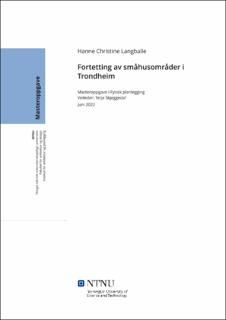| dc.contributor.advisor | Terje Skjeggedal | |
| dc.contributor.author | Hanne Christine Langballe | |
| dc.date.accessioned | 2023-10-02T17:23:20Z | |
| dc.date.available | 2023-10-02T17:23:20Z | |
| dc.date.issued | 2022 | |
| dc.identifier | no.ntnu:inspera:114472274:66679868 | |
| dc.identifier.uri | https://hdl.handle.net/11250/3093585 | |
| dc.description.abstract | Trondheim er en by som vil oppleve en befolkningsvekst i årene framover, og med denne befolkningsveksten vil det være behov for flere boliger. Fortetting er, og har lenge vært, en sentral del av norske kommuners byutviklingspolitikk, da en mer kompakt by vil gi mindre biltransport og dermed redusert klimagassutslipp. Det er en pågående debatt som går ut på om kommunens fortetting i småhusområder har vært for lite helhetlig. Trondheim kommune ønsker å forhindre at fortettingstiltak gir utilsiktet effekt på småhusområder. Dette studiet tar for seg hvilke vurderinger og prinsipper som bør ligge til grunn når Trondheim kommune skal vurdere om et fortettingsprosjekt i et småhusområde bør gjennomføres eller ikke.
For å svare på dette undersøker oppgaven først hvilke vurderinger kommunen har gjort i planprosessen for småhusområder som har blitt fortettet i Trondheim kommune. Kommunens vurderinger blir undersøkt i fire fortettingsprosjekter i småhusområder i Trondheim, gjennom et dokumentstudie og dybdeintervjuer. Funnene går ut på at det er forskjellige momenter som blir vurdert, og enkelte av momentene blir ikke vurdert i tilstrekkelig grad.
Disse funnene blir videre brukt for å undersøke om fortettingsprosjektene gir positive/negative virkninger for småhusområdene, sammenliknet med kunnskapsstatus og teori om hva som er kriterier for god fortetting i Trondheim. Resultatene viser at kommunen bør vurdere momenter som stedskarakter og lokalisering av planområdet i større grad.
Resultatene ligger til grunn for anbefalingene for videre fortetting av småhusområder i Trondheim. For å nå nullvekstmålet bør kommunen vurdere prosjektenes lokalisering i forhold til Trondheim sentrum, lokalsentre, kollektivtilbud og sykkelnett. Kommunen bør også innføre strengere krav til bruk av stedsanalyser for å hindre ødeleggelse av småhusområdenes særpreg, og det bør lages en veileder for utarbeidelse av stedsanalyser. Det bør også innføres en maksgrense for tetthet ved utbygging i småhusområder.
Ved å implementere disse anbefalingene mener jeg fortettingsprosjektene vil føre til en positiv og mer helhetlig utvikling av småhusområdene. | |
| dc.description.abstract | Trondheim is a city that will experience a population growth in the years to come and with this population growth there will be a need for more houses. Densification is and has been a central part of the Norwegian municipalities' urban development policy, as a more compact city will result in less car transport and thus reduced greenhouse gas emissions. There is an ongoing debate about whether the municipality's densification in small house areas has not been holistic. Trondheim municipality wants to prevent the densification from having an unintended effect on small house areas. This study addresses the assessments and principles that should form the basis when Trondheim municipality is to assess whether a densification project in a small house area should be carried out or not.
To answer this, the thesis first examines what assessments the municipality has made in the planning process for small house areas that have been densified in Trondheim municipality. The municipality's assessments are examined in four densification projects in small house areas in Trondheim, through a document study and in-depth interview. The results are that there are different factors that are assessed, and some of the factors are not assessed to a sufficient degree.
These findings are further used to find out whether the densification projects have positive / negative effects on the small house areas, compared with previous research and theory of what are the criteria for good densification in Trondheim. The municipality should consider factors such as site character and location of the planning site to a greater extent.
The results form the basis for the recommendations for further densification of small house areas in Trondheim. In order to achieve the zero-growth goal, the municipality should consider the projects' location in relation to Trondheim city center, local centers, public transport and bicycle networks. The municipality should also introduce stricter requirements for the use of site analyzes to prevent the destruction of the small house areas' distinctive features and a guide should be made for the design of site analyzes. A maximum limit for density should also be introduced for development in small house areas.
By implementing these recommendations, I believe the densification projects will lead to a positive and more holistic development of the small house areas. | |
| dc.language | nob | |
| dc.publisher | NTNU | |
| dc.title | Fortetting av småhusområder i Trondheim | |
| dc.type | Master thesis | |
